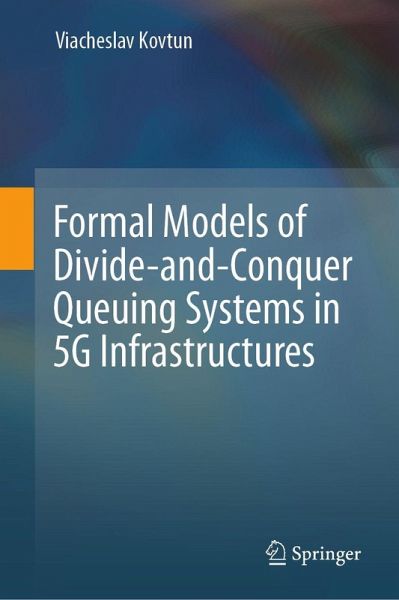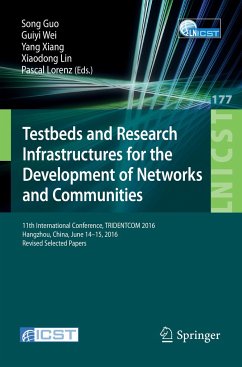
Formal Models of Divide-and-Conquer Queuing Systems in 5G Infrastructures
Versandkostenfrei!
Versandfertig in 6-10 Tagen
121,99 €
inkl. MwSt.

PAYBACK Punkte
61 °P sammeln!
In recent decades, the evolution of digital technologies has led to the proliferation of highly distributed, dynamic, and heterogeneous information and communication systems (ICS). Among them, 5G-IoT infrastructures, with their inherently dense topologies, variable load patterns, and heightened vulnerability to cyber threats, have introduced new challenges in ensuring resource efficiency, operational continuity, and dependable performance. These systems increasingly underpin critical domains such as - Industrial automation, smart energy, transportation, and healthcare-where failures or delays ...
In recent decades, the evolution of digital technologies has led to the proliferation of highly distributed, dynamic, and heterogeneous information and communication systems (ICS). Among them, 5G-IoT infrastructures, with their inherently dense topologies, variable load patterns, and heightened vulnerability to cyber threats, have introduced new challenges in ensuring resource efficiency, operational continuity, and dependable performance. These systems increasingly underpin critical domains such as - Industrial automation, smart energy, transportation, and healthcare-where failures or delays are intolerable. Consequently, the demand for robust analytical models capable of capturing the complexity of such infrastructures has never been greater.
This monograph emerged from the recognition that conventional queuing theory frameworks, while effective in classical settings, often fall short when applied to multi-channel systems with synchronisation mechanisms, heterogeneous service policies, and non-Poissonian traffic flows-features that are now typical in modern ICS architectures. To address this gap, the work explores and generalises a class of systems inspired by the "divide and conquer" (DC) paradigm. By formalising DC-like queuing systems, in which incoming requests are decomposed into multiple subrequests, processed in parallel, and synchronised upon completion, the study provides a coherent mathematical foundation for analysing their behaviour under both nominal and stress conditions.
The first part of the monograph establishes the conceptual and mathematical core of DC-like systems, including well-known configurations such as Split-Merge (SM), Fission-Fusion (FF), Team Service Models (TSM), and Independent Server Models (ISM). These systems are studied through rigorous formulations using two-dimensional Markov chains, exact generating functions, and the evaluation of response time and synchronisation delay. In particular, special attention is given to the interdependence of queues, which is often overlooked in simpler models.
The second part significantly extends this foundation by integrating Batch Markovian Arrival Processes (BMAP) and non-exponential service time distributions (Erlang, Cox, and hyper-exponential laws). This allows for a more realistic characterisation of input traffic, reflective of bursty, correlated, and priority-driven request flows typical of real-world 5G-IoT systems. A range of advanced mathematical tools is introduced, including the matrix-geometric method, order statistics, and extreme value theory, enabling the derivation of upper and lower bounds for key performance indicators.
From a methodological standpoint, the monograph proposes a hybrid analytical framework that combines exact modelling with tractable approximations, enabling the evaluation of systems beyond the scope of closed-form solutions. The interplay between queueing networks, synchronisation mechanisms, and traffic dynamics is systematically explored, leading to novel approximations for maximum response time, synchronisation variance, and buffer overload probabilities. Furthermore, the integration of stochastic update models, which mimic defensive behaviour under cyber threats, expands the applicability of the framework to security-aware system design.
This monograph is intended for a broad audience of specialists working at the intersection of queueing theory, distributed systems modelling, information and communications, and cybersecurity. It may serve as a theoretical reference for academic researchers, a methodological guide for systems engineers, and a basis for postgraduate education in performance modelling. The results presented here may also be of interest to designers of cloud-native services, sensor networks, and next-generation intelligent infrastructure.
This monograph emerged from the recognition that conventional queuing theory frameworks, while effective in classical settings, often fall short when applied to multi-channel systems with synchronisation mechanisms, heterogeneous service policies, and non-Poissonian traffic flows-features that are now typical in modern ICS architectures. To address this gap, the work explores and generalises a class of systems inspired by the "divide and conquer" (DC) paradigm. By formalising DC-like queuing systems, in which incoming requests are decomposed into multiple subrequests, processed in parallel, and synchronised upon completion, the study provides a coherent mathematical foundation for analysing their behaviour under both nominal and stress conditions.
The first part of the monograph establishes the conceptual and mathematical core of DC-like systems, including well-known configurations such as Split-Merge (SM), Fission-Fusion (FF), Team Service Models (TSM), and Independent Server Models (ISM). These systems are studied through rigorous formulations using two-dimensional Markov chains, exact generating functions, and the evaluation of response time and synchronisation delay. In particular, special attention is given to the interdependence of queues, which is often overlooked in simpler models.
The second part significantly extends this foundation by integrating Batch Markovian Arrival Processes (BMAP) and non-exponential service time distributions (Erlang, Cox, and hyper-exponential laws). This allows for a more realistic characterisation of input traffic, reflective of bursty, correlated, and priority-driven request flows typical of real-world 5G-IoT systems. A range of advanced mathematical tools is introduced, including the matrix-geometric method, order statistics, and extreme value theory, enabling the derivation of upper and lower bounds for key performance indicators.
From a methodological standpoint, the monograph proposes a hybrid analytical framework that combines exact modelling with tractable approximations, enabling the evaluation of systems beyond the scope of closed-form solutions. The interplay between queueing networks, synchronisation mechanisms, and traffic dynamics is systematically explored, leading to novel approximations for maximum response time, synchronisation variance, and buffer overload probabilities. Furthermore, the integration of stochastic update models, which mimic defensive behaviour under cyber threats, expands the applicability of the framework to security-aware system design.
This monograph is intended for a broad audience of specialists working at the intersection of queueing theory, distributed systems modelling, information and communications, and cybersecurity. It may serve as a theoretical reference for academic researchers, a methodological guide for systems engineers, and a basis for postgraduate education in performance modelling. The results presented here may also be of interest to designers of cloud-native services, sensor networks, and next-generation intelligent infrastructure.












